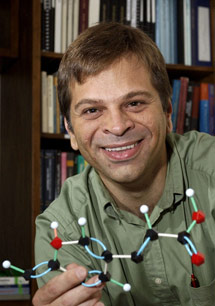
Handy Links
SLAC News Center
SLAC Today
- Subscribe
- Archives: Feb 2006-May 20, 2011
- Archives: May 23, 2011 and later
- Submit Feedback or Story Ideas
- About SLAC Today
SLAC News
Lab News
- Interactions
- Lightsources.org
- ILC NewsLine
- Int'l Science Grid This Week
- Fermilab Today
- Berkeley Lab News
- @brookhaven TODAY
- DOE Pulse
- CERN Courier
- DESY inForm
- US / LHC
SLAC Links
- Emergency
- Safety
- Policy Repository
- Site Entry Form

- Site Maps
- M & O Review
- Computing Status & Calendar
- SLAC Colloquium
- SLACspeak
- SLACspace
- SLAC Logo
- Café Menu
- Flea Market
- Web E-mail
- Marguerite Shuttle
- Discount Commuter Passes
-
Award Reporting Form
- SPIRES
- SciDoc
- Activity Groups
- Library
Stanford
Around the Bay
Ultrafast Theory at PULSE
Vision is fast. Light hits molecules in your eye and triggers a cascade of signals to paint a picture in your brain in real time. But scientists at the PULSE Institute for Ultrafast Energy Science study even faster events. Some PULSE researchers want to understand how molecules, such as those in your eye, respond the instant light strikes them.
Theoretical chemist Todd Martinez builds computational models of these chemical instants. He is joining PULSE this month, to study the world of ultrafast chemistry that will become accessible through the Linac Coherent Light Source.
"Todd helps us a lot by filling in a very important gap. His group will be the first theory group at PULSE," said PULSE Director Phil Bucksbaum. "He creates a lot of excitement in the kinds of computational chemistry that we're interested in."
Martinez models how the electrons and nuclei of atoms react mere femtoseconds, or quadrillionths of a second, after they're bombarded with light. When light hits a molecule, its energy excites electrons in the atoms that make up the molecule. As the electrons relax, their energy spreads to the nuclei of the atoms, which begin to move. These motions eventually lead to the molecular rotations and shape changes of chemical reactions.
By understanding this light-sparked chemistry, researchers hope to advance energy technology—for example, to improve the efficiency of solar cells that convert light energy into electrical energy. Silicon-based solar cells can't handle the energy packed in the sun's light. About two-thirds of the energy is lost as heat. Martinez models the super brief chemical steps that are the source of this inefficiency.
Bacteria also deal with these inefficiencies when they harness the sun's energy. Bucksbaum and Martinez study a protein called bacteriorhodopsin that bacteria use to turn light into chemical power, to examine how nature overcomes these challenges of solar power.
"[Bacteriorhodopsin] is really like a bacterial battery charger," Bucksbaum said. "If nature can produce a molecule that transforms light energy into chemical energy, people who want to convert solar energy into chemical energy may find some new ideas about how to put together these systems."
To study the brief chemical blips of molecules such as bacteriorhodopsin, scientists need to know the basic rules of how light and molecules interact. These rules are explained by mathematical equations chemists and physicists have used for decades. For simple molecules, they can easily solve these formulas. But for more complex molecules or large chemical systems found in nature, the equations become unsolvable. Instead, theoretical chemists like Martinez devise methods to approximate the answers.
"The basic equations are all known, but that's different from whether or not you can really solve these equations to some reasonable degree of approximation for complex systems," Martinez said. "We develop methods that allow you to solve these equations better and better."
Martinez not only creates novel methods to solve these equations, but he also develops novel computer systems to crunch the numbers. In 2002, he and scientists in his group devised a way to use the inexpensive hardware in Playstation II game consoles to run their molecular models. More recently, they've started using computer graphics cards instead of the consoles.
Here at SLAC National Accelerator Laboratory, Martinez believes his models could be used to interpret experiments at the Linac Coherent Light Source, which will allow scientists to study molecules on the ultrafast time scales he models. By simulating the behavior of molecules that users will place in front of the LCLS X-ray beam, Martinez's calculations could provide novel interpretations of these complex experiments. And results from the experiments will help Martinez to shape future models.
"LCLS is a great opportunity for an interplay where theory and experiment give each other advice," Martinez said.
—Michael Torrice
SLAC Today, January 6, 2009
